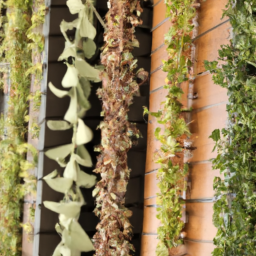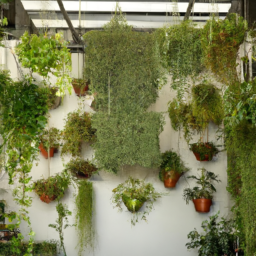
Vertical Gardens: Greening Up Urban Spaces
Welcome to our blog post on the topic of vertical gardens and how they are revolutionizing urban spaces. In today’s fast-paced and concrete jungle-like cities, finding a patch of greenery can be a challenge. However, with the rise of vertical gardens, urban dwellers can now bring nature back into their lives, transforming empty walls and rooftops into lush, thriving ecosystems. In this article, we will explore the concept of vertical gardens, their benefits, and how they are reshaping the way we think about urban landscapes. So, whether you are a city dweller longing for a touch of nature or a gardening enthusiast looking for innovative ways to grow plants, keep reading to discover the wonders of vertical gardens and how they are greening up urban spaces.
body {
font-family: Arial, sans-serif;
font-size: 16px;
line-height: 1.6;
margin: 20px;
}
h2 {
font-size: 24px;
font-weight: bold;
margin-bottom: 10px;
}
h3 {
font-size: 20px;
font-weight: bold;
margin-bottom: 10px;
}
p {
margin-bottom: 20px;
}
Benefits of Vertical Gardens in Urban Spaces
Vertical gardens, also known as green walls or living walls, have become increasingly popular in urban spaces due to their numerous benefits. These innovative structures not only add aesthetic appeal to concrete jungles but also offer a range of environmental, social, and economic advantages. In this article, we will explore the various benefits of vertical gardens and how they contribute to greening up urban spaces.
Improving Air Quality
One of the key advantages of vertical gardens is their ability to improve air quality in urban areas. Plants naturally absorb carbon dioxide and release oxygen through photosynthesis, helping to reduce pollution levels. By incorporating vertical gardens into urban spaces, we can significantly enhance air quality by increasing the overall greenery and plant density. This helps to filter out harmful pollutants, such as nitrogen dioxide and particulate matter, resulting in cleaner and healthier air for city dwellers.
Moreover, vertical gardens act as natural air purifiers by absorbing various toxins and volatile organic compounds (VOCs) present in the atmosphere. These pollutants are commonly emitted by vehicles, industrial activities, and other urban sources. Vertical gardens, with their diverse plant species, provide an effective means of mitigating the negative impacts of urban pollution and promoting a healthier urban environment.
Additionally, the presence of vertical gardens helps to reduce the urban heat island effect. The dense vegetation and foliage act as natural insulators, reducing the surface temperature of buildings and surrounding areas. This, in turn, decreases the energy consumption required for cooling, resulting in lower greenhouse gas emissions and energy costs.
Enhancing Biodiversity
Urban areas often lack sufficient green spaces, leading to a decline in biodiversity. Vertical gardens offer a unique opportunity to reintroduce plant and animal species into urban environments, thereby promoting biodiversity conservation. By incorporating a variety of plant species in vertical gardens, we can create habitats for birds, bees, butterflies, and other pollinators. These green structures act as stepping stones for wildlife, facilitating their movement and providing essential food and shelter.
Furthermore, vertical gardens contribute to the preservation of endangered plant species by providing a controlled environment for their growth. By cultivating rare and threatened plants in vertical gardens, we can protect them from urban development and habitat destruction, ensuring their survival for future generations.
The presence of green spaces in urban areas also has a positive impact on human well-being. Studies have shown that exposure to nature and greenery can reduce stress levels, improve mental health, and enhance overall quality of life. Vertical gardens provide an accessible and visually appealing way to incorporate nature into our daily lives, even in the midst of bustling cities.
Maximizing Space Efficiency
With urban spaces becoming increasingly limited, vertical gardens offer a practical solution for maximizing space efficiency. By utilizing vertical surfaces, such as walls and facades, we can transform underutilized spaces into vibrant green areas. This vertical expansion allows for the cultivation of a large number of plants in a relatively small footprint, making it ideal for densely populated urban areas.
Vertical gardens also have the potential to enhance food security in urban spaces. By growing edible plants and vegetables in vertical gardens, we can promote urban agriculture and reduce the reliance on long-distance food transportation. This not only improves access to fresh and nutritious produce but also reduces the carbon footprint associated with food production and distribution.
In addition, vertical gardens act as natural insulation, reducing the energy consumption required for heating and cooling buildings. The plants create a microclimate that helps regulate temperature fluctuations, resulting in energy savings and reduced greenhouse gas emissions.
In conclusion, vertical gardens offer a multitude of benefits for greening up urban spaces. From improving air quality and enhancing biodiversity to maximizing space efficiency and promoting food security, these green structures provide a sustainable and visually appealing solution for urban environments. By incorporating vertical gardens into our cities, we can create healthier, more vibrant, and environmentally conscious urban spaces.

Designing and Implementing Vertical Gardens in Urban Areas
Welcome to the world of vertical gardens, where urban spaces are transformed into lush green landscapes. In this article, we will explore the step-by-step process of designing and implementing vertical gardens in urban areas. Whether you are a gardening enthusiast or an urban planner, this guide will provide you with valuable insights into creating stunning vertical gardens that not only beautify but also contribute to a sustainable environment.
Choosing the Right Location
The first step in designing a vertical garden is selecting the right location. Consider the amount of sunlight, wind exposure, and accessibility of the area. Ideally, choose a spot that receives at least six hours of direct sunlight daily. This will ensure the healthy growth of plants. Additionally, take into account the availability of water sources and the structural integrity of the building or structure where the vertical garden will be installed.
Once you have identified a suitable location, measure the dimensions of the area. This will help you determine the number of vertical garden modules or structures needed. Remember to leave enough space for pathways and maintenance access.
Lastly, consider the aesthetic aspect of the location. Vertical gardens can be used to enhance the visual appeal of urban spaces. Think about how the vertical garden will complement the surrounding architecture and landscape.
Choosing the Right Plants
The selection of plants is crucial for the success of a vertical garden. Choose plants that are well-suited for vertical growth and can thrive in the specific environmental conditions of the chosen location. Consider factors such as sunlight requirements, water needs, and temperature tolerance.
When it comes to vertical gardens, there are various options to choose from. You can opt for climbing plants, such as ivy or jasmine, which naturally grow upwards and require minimal support. Alternatively, you can use modular systems that allow for a wide variety of plant choices. These systems often include built-in irrigation and drainage systems, making maintenance easier.
It is also important to consider the weight of the plants and the structure’s load-bearing capacity. Consult with a structural engineer if necessary to ensure the safety of the vertical garden.
Installation and Maintenance
Once you have chosen the location and plants, it’s time to install the vertical garden. Start by preparing the structure or modules according to the manufacturer’s instructions. Ensure that the irrigation system is properly set up and tested.
Next, position the plants in their designated spots, taking care to provide enough space for growth. Secure the plants using appropriate support systems, such as trellises or wires. Be mindful of the plant’s natural growth pattern and guide them accordingly.
Regular maintenance is essential for the health and longevity of the vertical garden. Monitor the plants for signs of pests, diseases, or nutrient deficiencies. Prune and trim the plants as necessary to maintain their shape and prevent overgrowth. Regularly check the irrigation system and adjust the watering schedule based on the season and weather conditions.
Additionally, consider incorporating a fertilization schedule to provide essential nutrients to the plants. Organic fertilizers or slow-release fertilizers are often recommended for vertical gardens as they promote sustainable and healthy growth.
Lastly, educate yourself about the specific care requirements of the chosen plant species. Different plants have different needs, and understanding these requirements will help you provide the best possible care for your vertical garden.
Designing and implementing vertical gardens in urban areas is an exciting endeavor that can transform the concrete jungle into a vibrant oasis. By carefully selecting the location, choosing the right plants, and providing proper installation and maintenance, you can create a sustainable and visually appealing vertical garden that brings nature back to the city.

Maintenance and Care Tips for Vertical Gardens in Urban Environments
Introduction
Vertical gardens, also known as living walls or green walls, have become increasingly popular in urban environments. These innovative structures not only add beauty and aesthetic appeal to buildings but also provide numerous environmental benefits. However, like any other garden, vertical gardens require regular maintenance and care to thrive in urban settings. In this article, we will provide you with a step-by-step guide on how to maintain and care for vertical gardens in urban environments.
Choosing the Right Plants
The first step in maintaining a vertical garden is to choose the right plants. Urban environments can be challenging for plants due to limited space, pollution, and harsh weather conditions. Therefore, it is crucial to select plants that are well-suited for these conditions. Consider plants that are known for their resilience, drought tolerance, and ability to withstand pollution. Some popular choices for vertical gardens in urban environments include ferns, succulents, and certain types of ivy.
When selecting plants, also pay attention to their growth habits and requirements. Some plants may require more sunlight, while others thrive in shade. Ensure that the plants you choose have similar light and water requirements, as this will make maintenance easier and more efficient.
Watering
Proper watering is essential for the health and longevity of vertical gardens in urban environments. Due to their vertical nature, these gardens may have different watering needs compared to traditional gardens. It is important to water the plants thoroughly, ensuring that the water reaches all levels of the vertical garden.
One effective way to water vertical gardens is through an automated irrigation system. These systems can be programmed to deliver water at specific intervals, ensuring that the plants receive adequate moisture. Additionally, consider using a water-soluble fertilizer to provide essential nutrients to the plants.
Regularly monitor the moisture levels in the soil and adjust the watering schedule accordingly. Overwatering can lead to root rot, while underwatering can cause the plants to dry out and wither. Finding the right balance is crucial for the health of your vertical garden.
Pruning and Trimming
To maintain the aesthetic appeal of your vertical garden, regular pruning and trimming are necessary. Over time, some plants may become overgrown or develop dead or damaged foliage. Pruning helps to remove these unwanted parts and promotes healthy growth.
When pruning, use clean and sharp tools to avoid damaging the plants. Remove any dead or yellowing leaves, as they can attract pests and diseases. Trim back any overgrown branches or vines that may be obstructing the overall structure of the vertical garden.
Pest and Disease Control
Like any garden, vertical gardens are also susceptible to pests and diseases. Urban environments, with their higher pollution levels and limited natural predators, can exacerbate these issues. Regularly inspect your vertical garden for signs of pests such as aphids, mealybugs, or spider mites. If you notice any infestations, take immediate action to prevent further damage.
There are several natural methods for controlling pests in vertical gardens. Introduce beneficial insects like ladybugs or lacewings that feed on pests. Use organic insecticidal soaps or neem oil sprays to deter common pests. Avoid using harsh chemical pesticides, as they can harm beneficial insects and disrupt the ecological balance of your vertical garden.
Conclusion
Vertical gardens in urban environments require regular maintenance and care to thrive and provide their numerous benefits. By choosing the right plants, watering properly, pruning and trimming, and implementing pest and disease control measures, you can ensure the health and longevity of your vertical garden. Remember to monitor the plants closely, make adjustments as necessary, and enjoy the beauty and greenery that these unique structures bring to urban spaces.
Summary Snapshot
Vertical gardens, also known as living walls or green walls, have become a popular solution for bringing nature into urban spaces. With the increasing population and limited land availability in cities, vertical gardens offer a creative and sustainable way to add greenery to our concrete jungles. These innovative structures can be found on the sides of buildings, fences, or even freestanding, and are designed to maximize the use of vertical space.
One of the main advantages of vertical gardens is their ability to improve air quality in urban areas. By absorbing carbon dioxide and releasing oxygen, these living walls act as natural air filters, reducing pollution and creating a healthier environment for city dwellers. Additionally, vertical gardens can help regulate temperature by providing shade and insulation, which can be especially beneficial in hot climates. Moreover, these green walls are known for their aesthetic appeal, transforming dull and monotonous facades into vibrant and visually pleasing displays of nature. Whether it’s a small, indoor garden or a large, outdoor installation, vertical gardens have the power to enhance the beauty of urban spaces while promoting sustainability and well-being.
Here are some FAQs you’d be interested in:
Q1: What are vertical gardens?
A1: Vertical gardens, also known as living walls or green walls, are structures that allow plants to grow vertically on a wall or other vertical surface. These gardens are designed to maximize the use of limited space in urban areas, bringing nature into the concrete jungle.
Q2: Why are vertical gardens popular in urban spaces?
A2: Vertical gardens have gained popularity in urban spaces for several reasons. Firstly, they provide a solution for limited space by utilizing vertical surfaces that would otherwise be unused. Secondly, they improve air quality by absorbing pollutants and releasing oxygen. Additionally, vertical gardens create a visually appealing and calming environment, enhancing the overall well-being of urban residents.
Q3: What are the benefits of vertical gardens?
A3: Vertical gardens offer numerous benefits. They help to reduce the urban heat island effect by providing shade and cooling the surrounding area. They also act as natural insulation, reducing energy consumption in buildings. Vertical gardens can improve air quality by filtering pollutants and reducing noise pollution. Moreover, they contribute to biodiversity by providing a habitat for birds, insects, and other wildlife.
Q4: What types of plants are suitable for vertical gardens?
A4: A wide variety of plants can be grown in vertical gardens, depending on factors such as sunlight exposure, climate, and maintenance requirements. Some popular choices include ferns, succulents, herbs, and flowering plants. It’s important to select plants that are suitable for vertical growth and have the ability to thrive in the specific conditions of your urban space.
Q5: How can I create a vertical garden in my urban space?
A5: Creating a vertical garden in your urban space is an exciting project. Start by assessing the available space, considering factors like sunlight exposure and structural support. Next, choose the appropriate plants and install a suitable support system such as trellises or modular panels. Ensure proper irrigation and drainage to keep the plants healthy. Regular maintenance, including watering, pruning, and fertilizing, is crucial for the success of your vertical garden.

Alex Turner is a sustainable gardening advocate and the founder of an acclaimed indoor gardening blog. With a focus on eco-friendly practices and urban sustainability, Alex combines his background in environmental studies with his love for plants to educate readers on mindful indoor gardening. His work highlights the importance of nurturing both plants and the planet.


